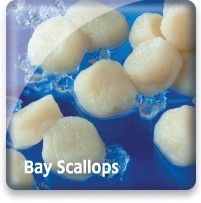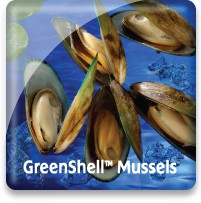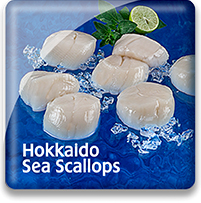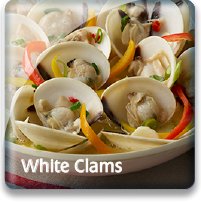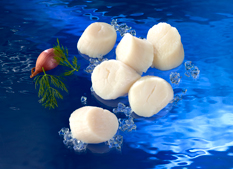
Sea Scallops

Market Name: Eating QualitiesSea Scallops have that wonderfully unique "scallop flavor". The intensity of this natural flavor can vary do to the amount of water that the scallop meat absorbs on the fishing vessels at sea before landing or during processing after landing. The intensity of the scallop flavor and the texture of the meat can sometimes be diminished by the use of sodium tripolyphosphate and other moisture enhancing additives. However, whether untreated or treated, sea scallops are delicious, highly nutritious, and fun to eat.
Unlike other bivalves such as mussels and clams, scallops can swim by opening and closing their shells quickly.
|
Description & CharacteristicsThe sea scallop is a bi-valve mollusk. The part eaten is the abductor muscle; this is the cylindrical white meat that holds the two shells together. Most scallops sold in the U.S.A. are caught on or near the Georges Bank Fishing grounds, in the northeast Atlantic, close to New England and the Canadian Maritimes.Sea scallops are predominantly caught by dredges. Because scallops do not live long out of water, they are shucked by hand on the boats so that only the meats are brought ashore. The scallop industry is highly regulated and is considered one of the most sustainably managed fisheries in the United States. Controls are in place to regulate the size of scallops, the fishing grounds, and the harvest season. Scallops are a major seafood commodity in the U.S. The market standard is set by the large sea scallops from the Northeast with New Bedford, Massachusetts being the epicenter for sea scallop landings and trade in the U.S. The auction there plays a large part in determining the price of sea scallops nationwide. Scallops marketed in the U.S. are commonly processed in phosphate dips in order to have the meats retain moisture for enhancing protection against freezer burn when processing and while in cold storage and to gain weight for economic reasons. The use of phosphate dips or other additives must be noted on the label. However, more recently, there has been an increase in “dry” or non-phosphate dipped scallops in the marketplace. Scallops are marketed as either processed or dry in the U.S. Sea scallops are graded by size, typically in 10/20, 20/30, 20/40 and 30/40 counts. The U.S. scallop supply is supplemented by imports of sea scallops from China, Korea, Japan, Mexico, and Canada. Other Resources |
Handling Instructions for Sea Scallop
Frozen sea scallops should be stored at or below 0°F (-18°C) and then thawed properly when ready to cook. Our frozen sea scallops can be stored frozen for up to 18 months. Links to proper seafood handling instructions: NOAA - Fish Watch: Handling Seafood and A Consumer Guide to Safe Seafood Handling.
Thawing Sea Scallop
Our sea scallops should be thawed by removing them from their package and placing them in a sealed plastic bag or container and placed in the refrigerator (33 to 39°F) for 12 to 24 hours or until completely thawed. To speed up this thawing process, IQF sea scallops can also be placed in a colander and rinsed under cold water to remove any ice glazing and then placed in the refrigerator for proper thawing. Sea scallops should not be completely quick thawed in a colander under cold running water because their natural flavors have a tendency to be easily washed away. Sea scallops that are not consumed immediately after complete thawing need to be refrigerated between 33 and 39°F and consumed within 2-3 days.
Important Instructions for Sea Scallop
Upon complete thawing, gently remove the scallops from the milky colored natural scallop juices that have seeped from the scallops during thawing. This weeping of juices is perfectly normal. Sea scallops that are cooked immediately after thawing produce the best quality.
Cooking Tips
Raw sea scallops are quick and easy to cook in as little as 7-14 minutes by baking, steaming, boiling, broiling, barbecuing or pan frying. Sea scallops are delicate in texture and taste and should not be overcooked or they can become rubbery and lose flavor. Links to cooking tips and recipes: Seared Scallop Recipe and Scallop Selection and Storage.
The United States
The United States of America has over 95 thousand miles of coastline, ranks fourth in the world in wild capture fisheries and thirteenth in aquaculture production. The wild capture fisheries is dominated by Alaska pollock and followed by menhaden, salmon, flatfish, and cod. After these wild caught finfish species which comprise 84% of the entire wild catch, the remaining capture fisheries primarily consist of crab, shrimp, and shellfish. Aquaculture production in the U.S. is comprised of roughly 70% freshwater and 30% marine farms. Freshwater aquaculture is dominated by catfish and followed by trout production while the marine aquaculture in comprised of 65% shellfish (clams, oysters, & mussels), 25% salmon, and 10% shrimp. At present, aquaculture represents 5% of the total U.S. seafood production. The long term sustainability of U.S. wild fisheries has been the goal of the 1976 Magnuson-Stevens Act. The National Marine Fisheries Service manages all activities to achieve this goal and at this time the majority of wild capture fisheries in the U.S. are sustainable. In 2011 the U.S. Department of Commerce and the National Oceanic and Atmospheric Administration released policies that promote the accelerated development of marine aquaculture. Both wild fisheries and aquaculture in the United States are currently well managed for sustainable growth.
Canada
Canada is almost a carbon copy of the United Sates in terms of land mass and miles of coastline. This makes Canada very similar to the United Sates in terms of fishery resources with the exceptions of the U.S. warm water fisheries along the Gulf coasts and Hawaii. Canada’s wild fishing industry operates on the Atlantic and Pacific coasts, and on more than 800 freshwater lakes in between. The country exploits more than 100 commercially valuable species of fish. The top wild species caught are hake, ocean perch, cod, herring, salmon, capelin, cold water shrimp, snow crab, rock crab, lobster, halibut, and scallops. Canada’s aquaculture production is growing and is primarily comprised of salmon, steelhead, mussels, oysters, scallops, trout, Arctic char, with additional progress being made with black cod, halibut, haddock, eel, tilapia, sea urchin, quahog clams, and geoduck clams. Canada has strong nationwide fishery and aquaculture management in place to help advance their sustainable development.
Japan
Japan is an island nation that historically has had worldwide access to all the worlds fishing grounds to supply its seafood loving population who have the highest per capita seafood consumption of any developed nation. This access was severely curtailed in 1982 by the worldwide adoption of the UN Convention on the Law of the Sea that established 200 mile marine Exclusive Economic Zones for all nations with coastlines. In spite of this historical development, Japan today ranks fifth in world production of wild fisheries which comprises approximately 65% of their seafood production while aquaculture currently comprises the remaining 35% of their seafood production. Japan’s aquaculture production ranks 10th in the world and produces various shellfish, finfish, and seaweed. Japan consumes approximately 10% of the entire world’s wild caught fisheries which is comprised of a vast variety of finfish, crustaceans, and shellfish. Japan is also consuming an ever growing percentage of the world’s aquaculture production. They import much more seafood than they export, but the seafood they do export is generally considered to be high quality.
Go Blue! Seafood Sustainability Spectrum*Click here for an explanation of our Sustainability Spectrum 
Sustainability AssessmentSea Scallops in the northwest Atlantic Ocean are found from Newfoundland to North Carolina and are caught primarily using dredges. Scallop dredges drag across the ocean floor, but most Sea Scallops are fished on sandy bottoms, which recovers quickly. The US Sea Scallop fishery is the largest wild scallop fishery in the world, with the majority landed in Massachusetts and New Jersey. Sea Scallops are not overfished in the US, nor is overfishing occurring according to the latest stock assessment. There is limited access to this fishery, and there are rotating closed management areas. Fishing effort has been reduced to keep the stock from being overfished. Bycatch species in the Sea Scallop fishery include sea turtles and groundfish, especially cod and yellowtail flounder, and these numbers need to be monitored. Starting in 2013, all scallop vessels that fished in the Mid-Atlantic had to use Turtle Deflector Dredges in places and at times where sea turtles occurred on the scallop grounds. The Turtle Deflector Dredge excludes sea turtles from being caught in the dredge. On December 19th, 2013 the North Atlantic Sea Scallop fishery was certified as being responsibly managed and sustainable by the Marine Stewardship Council. Additionally, Sea Scallop fisheries in Japan , China, and Canada have achieved MSC sustainability certification.
Environmental Impact: Low to ModerateSea Scallops are abundant, and the rotating closed areas help to ensure abundance levels remain high. Scallops are dredged, which disturbs the ocean floor, although the sandy bottom where scallops are found can recover more quickly than other types of habitat. Groundfish and sea turtles can be caught in scallop dredges, but management measures in place ensure that these interactions are reduced to low levels that do not negatively impact these populations.
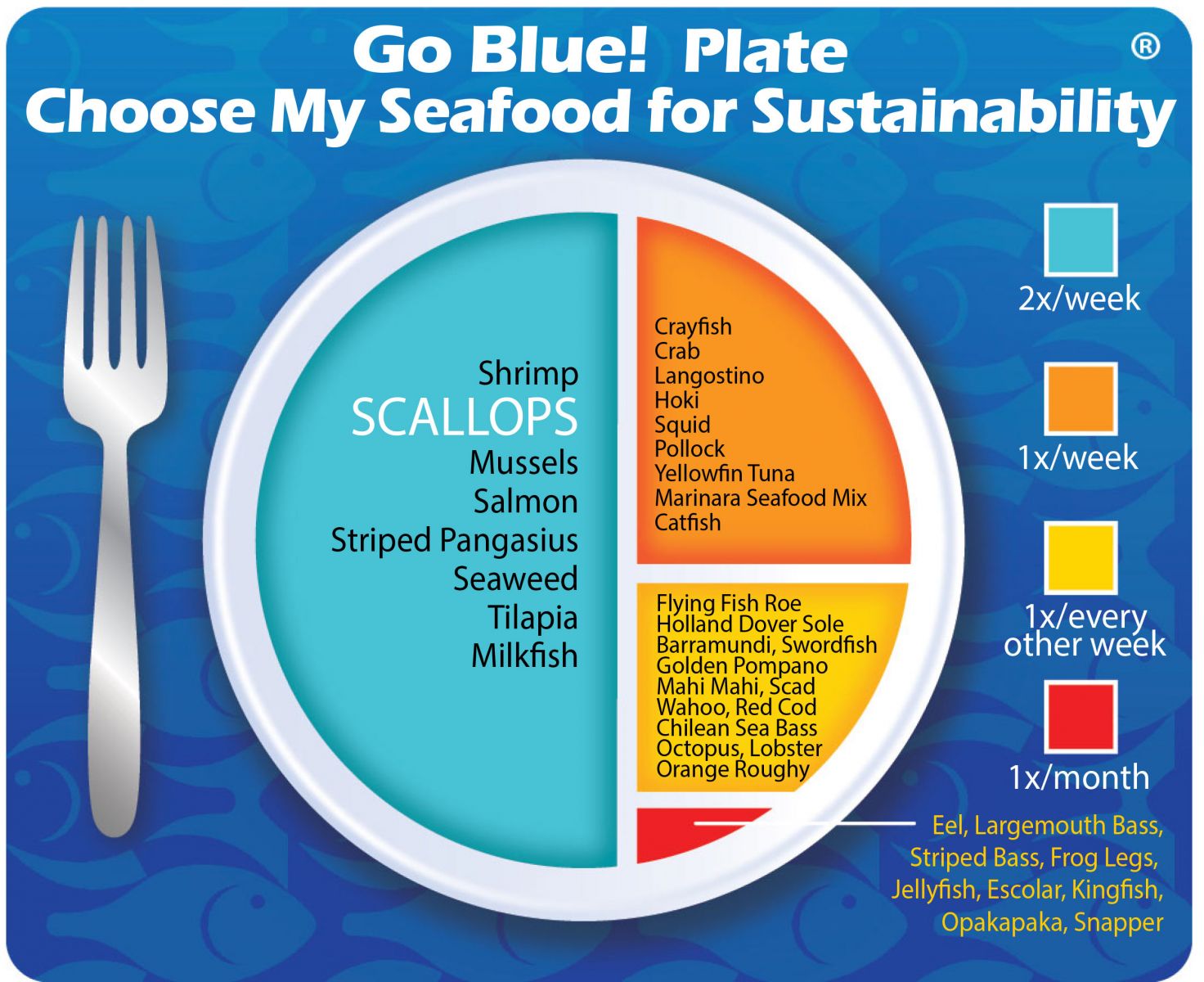
Sustainability Improvements NeededImprovements are needed to further reduce groundfish bycatch and sea turtle interactions. Reducing the time dredges are dragged on the bottom would also reduce the impacts to the bottom habitat. This can be done through gear modification or mapping the seafloor.
Actions that Sea Port is UndertakingSea Port supports this fishery and by doing so will help advance the environmental sustainability of this well managed fishery. This well managed wild scallop fishery adds another sustainable and responsibly produced seafood to a growing variety of seafood choices that will help sustain the health of both humans and the planet’s ecosystems. Sea Port believes that, in aggregate, choosing from a diverse variety of seafood is better for sustaining the world’s seafood resources and that Sea Scallops should be a part of this variety.
We created the sustainability assessments for each of our seafood items in order to reveal the existing and potential environmental impacts and risks that are associated with producing them for human consumption. This allowed us to establish the starting position for each of our seafood items along our progressive Go Blue! Seafood Sustainability Spectrum®. These assessments are only a single snapshot in time and because of this, we will continue to assess and update the critical sustainability needs associated with our supply sources and issue updates to the Go Blue! Seafood Sustainability Spectrum® as needed. There is a growing global awareness for the need to assure the sustainability of farmed and wild caught seafood and because of this; all around the world positive changes are rapidly occurring at all levels of the seafood supply chain. We will continue to spread this growing awareness and work with our many industry partners to improve the sustainability of all seafood, which we believe is the ideal protein of choice to feed an ever growing world population. Our Go Blue! Seafood Sustainability Spectrum® serves as our compass and yardstick as we strive to move all our products forward to becoming more sustainable. Please join us in this committed quest and Catch Our Wave® to sustainability by choosing a diverse variety of responsibly produced seafood as part of your diet.
|


